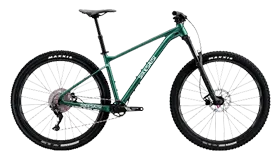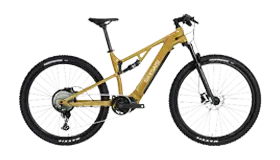Mountain Biking Tips
1. Correct riding posture:
① The upper body is low, and the head is slightly tilted and stretched forward;
② Bend your arms naturally to facilitate bending of the waist, lower the center of gravity of the body, and prevent the impact force caused by the bumps of the car from being transmitted to the whole body;
③ Hold the handle lightly but firmly with both hands, and sit firmly on the seat with your buttocks.
2. Proper use of bicycle pedals:
There are three pedaling methods for cycling: freestyle, toe-down style and heel-down style.
①Freestyle: At present, some excellent athletes mostly use the freestyle pedaling method. This method of pedaling means that during one rotation of the foot, the angle of the ankle joint changes depending on the location. Free-style pedaling conforms to the principles of mechanics. The direction of the force is consistent with the tangent line of the circle formed when the pedals rotate. It reduces the range of motion of the knee joint and thigh, which is beneficial to increasing the frequency of pedaling, naturally passing through the critical zone, and reducing dead spots. . The thigh muscles can also be relatively relaxed. But this pedaling method is difficult to master.
② Toe-down style: The characteristic of pedaling is that the toes are always downward during the entire pedaling rotation. This method has a smaller range of ankle joint movement, which is beneficial to increasing frequency and is easy to master, but the leg muscles are always in tension. The state is not conducive to passing through the critical zone naturally.
③Heel-down style: The heel-down style pedaling method is to point the toes slightly upward and the heels downward. This method is rarely used in normal riding, only when a few people make excessive adjustments during riding. Use the heel-down pedaling method. Its characteristic is that the muscles change their exertion state in a short period of time and get a short rest to achieve the purpose of recovering muscle fatigue.
3. Mountain bike turning skills:
① Tilt method: The car body is a line and tilted into the bend. The body's center of gravity is tilted inward into the bend based on the car, and the person and car maintain the same tilt angle. Straighten your outside knee and subconsciously add pressure, as if you're trying to push the pedal off (but don't ask us if you actually push it off), pressing your inside knee against the crossbar. This is A great way to adjust your trajectory is to reduce camber by reducing pressure. The outside hand pulls up the handlebar slightly. Two good times to use tilt: You can use less sharp turns (less than 45 degrees) to accelerate You can clearly see the front but unfamiliar bends Wet asphalt roads, two disadvantages of tilt: In rainy days, although this The turning technique can give you a good traction, but its angle and weight distribution and arrangement are not conducive to slippery roads; the tilting technique is not as sensitive as the corresponding twist.
② Handling method: Keep the car upright and lean your body into the bend. Move forward until your nose is in line with the brake lever. Keep the car upright and lean into the bend (enough to allow your outside arm to straighten). Tilt the handlebar to the inside of the bend. Bend the elbow of your inside arm to pull the handlebar back while your outside arm pushes the handlebar out to turn the handlebar direction. Keep your knees buckled in on both sides and continue pedaling.
4. Uphill riding techniques
When riding uphill, you must maintain normal pedaling movements and do not use sudden force. Under normal circumstances, it is not advisable to use standing riding or pull-up riding methods, otherwise it will consume too much energy. When encountering a short-distance slope, you should make full use of the inertia principle of object movement and pedal easily. When you are approaching the top of the slope, you can ride in a standing position to increase the speed as much as possible to create favorable conditions for downhill acceleration. When encountering a long uphill slope, you should adjust the transmission ratio in time according to your physical condition. Do not wait until you can no longer ride and the speed has completely dropped before changing the transmission ratio. You must resolutely avoid restarting. When the slope is long or steep, you can alternately use the standing riding method to adjust the part of the force and allow some muscles to rest. Don't follow the car too closely when going uphill. Due to the force exerted on going uphill, the vehicle often swings left and right. If you follow the vehicle too closely, a collision may occur. Furthermore, the speed drops significantly when going uphill, and following a car will limit your riding method.
5. Downhill riding techniques
To achieve the ideal effect when riding downhill, you must be brave, resourceful, bold and careful, concentrate your energy, keep your eyes on the road ahead, and be ready to deal decisively with any situation on the road at any time; not only must you make full use of the inertia of the car's motion, but also must Dare to take the initiative to pedal and increase speed. When turning, the body and the car should be aligned, tilt inward, and the upper body and the car should be kept in a straight line to overcome the centrifugal force. The tilt angle depends on the speed and the size of the curve, but generally it should not exceed 28 degrees, otherwise there is a risk of slipping. Control your speed before turning. Use the point brake method to gradually slow down. When braking, try to use the front and rear brakes at the same time. The front brake can be slightly advanced. When using the front brake, the direction of the front wheel must be consistent with the direction of the car. Otherwise, the rider's weight and The car's inertia is limited, causing it to fall. Release the brake after entering the curve to avoid unnecessary deceleration. Don't use the rear brake too hard on corners. Otherwise the car may turn around or slip.
6. Mountain bike braking skills
The front brake can provide you with very good braking power, but it can also turn you into a flying trapeze. Below we will tell you how to brake.
①When using the front brake, move the center of gravity rearward
When you apply the front brake, your center of gravity will naturally move forward due to inertia. You must practice consciously moving your center of gravity backward (lower your body and move your butt back) when you start to brake. The further your weight is shifted back, the more braking power you can use. You can practice on sand or a slightly slippery flat surface, increase your speed and apply different amounts of force on your front and rear brakes to learn how to control your braking. Or ask an expert how he uses the brakes while riding.
②Reduce the force of the front brake when turning
Just like driving a car, you have to reduce your speed when turning. If you apply your brakes hard while turning, you will skid and lose control. Use your front and rear brakes simultaneously to reduce your speed when turning. Your front wheel will react less when braking, so reduce front braking force and your turn will be more perfect. If you are making a sharp turn downhill and need to brake, try to use the power of the rear brake. For example, on flat ground, when braking at the last moment, lower the center of gravity back and use 30% of the braking force in the front and 70% of the braking force in the rear to make the braking action.
③Do not press the front brake excessively
Inertia is your friend, you need speed to get over rocks and obstacles. Otherwise the wheel will stop turning and throw you over the handle. Applying the front brake too much will shift your center of gravity forward, causing the front of the car to tilt down. If you use the front brake when turning on a steep downhill slope, you must control your front and rear brakes at the same time, and do not press it with excessive force. At this time, you can release and press the brake to prevent braking. Lockup occurs.










